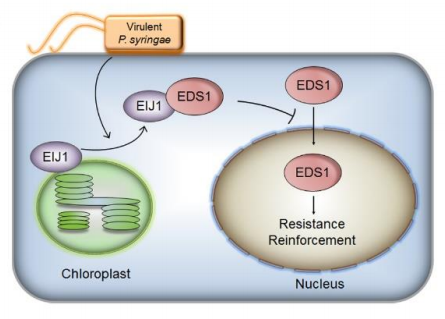Plants have evolved a set of highly sophisticated mechanisms to deal with environmental stresses and to survive in a cost-efficient manner. For example, upon pathogen attack, plants reallocate their limited resources away from growth towards defense against pathogens, and this trade-off between growth and defense is finely balanced to optimize fitness. To date, extensive researches on how plants recognize and response to pathogens have been done, but the molecular mechanisms underlying fine-tuning of the plant immune system remain elusive.
EDS1 is a positive regulator of basal resistance to biotrophic pathogens and TIR-NB-LRR protein-triggered immunity. Balance between nuclear and cytoplasmic EDS1 pools is important for a complete plant innate immune response and to avoid over-reaction of the plant immune system, yet little is known about the shuttling process of EDS1 between the nucleus and the cytoplasm.
LIU Hailun and LI Yuge from South China Botanical Garden of Chinese Academy of Sciences have reported a mechanism of EDS1-distribution fine-tuning. In this study, a combination of molecular, biochemical and genetic approaches is used to reveal the important role of EIJ1, an EDS1-interacting cochaperone protein, in the plant immune system, and proposed a model on how it regulates EDS1-dependent plant basal resistance.

Figure. Hypothetical model of EIJ1 regulating EDS1-dependent plant basal resistance
In normal condition, EIJ1 is mainly localized within chloroplasts. When plants are invaded by pathogens, EIJ1 is rapidly released from chloroplasts to the cytoplasm, where it interacts with EDS1 and prevent cytoplasmic EDS1 from shuttling into the nucleus. Thus the nuclear activity of EDS1 is delayed. When plants suffer continuous stimuli from invading pathogens, EIJ1 is gradually degraded, leading to an increased nuclear accumulation of EDS1 and therefore SA biosynthesis and expression of resistance-related genes, making up a complete immune response. In this way, plants fine-tune the strength of their immune response and avoid unnecessary cost due to over-reaction of the immune system. These findings illustrate an essential repressive role of EIJ1 during the early host response to pathogen invasion.
Notably, loss-of-function eij1 mutant plants showed normal growth, and EIJ1 gene is widely distributed among monocotyledonous and dicotyledonous plants. It provide a potential target for breeding of resistant varieties of crops.
The study has been published in the online edition of the international journal Plant Cell. For further reading, please refer to: https://doi.org/10.1093/plcell/koaa007.



